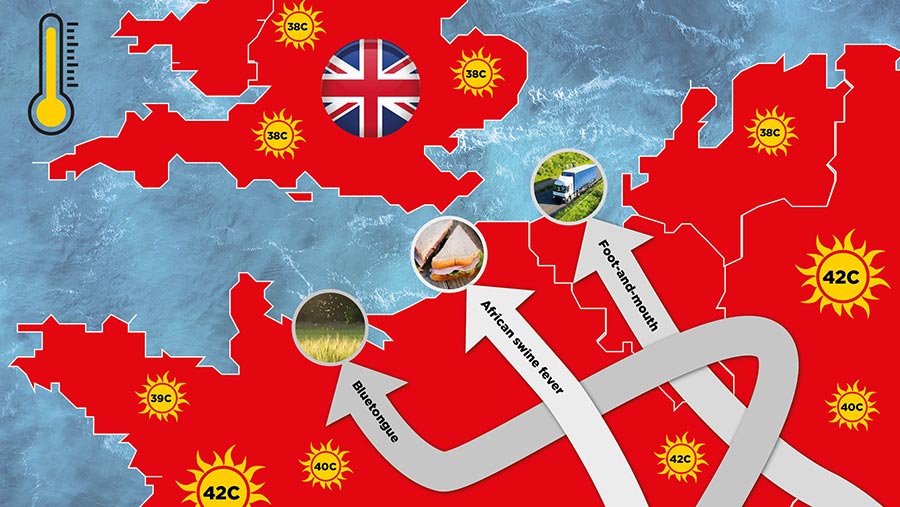Emerging livestock diseases – another unwanted climate change effect
 © Adobe Stock
© Adobe Stock Insect-borne livestock diseases that were once confined to the tropics are increasingly likely to threaten farms in the UK as climate change expands the number of countries where they can thrive.
A 2019 study, Bluetongue Risk Under Future Climates, which looked at how changing temperatures in northern Europe might affect outbreaks of bluetongue virus, suggested that an outbreak typically expected once every 20 years could become almost an annual occurrence by the 2070s in a worst-case climate change scenario.
See also: Why, when and how with vaccination for beef suckler cow diseases
One of the authors, Andrew Morse, says the UK is already vulnerable to vector-borne diseases but, as the temperature increases, the risks will be much higher.
“We expect that risk forecasting and early, accurate disease detection, along with efficient strategies for disease control, will become increasingly vital in future, warmer climates,” says Prof Morse, who leads on climate impacts at the University of Liverpool.
History
UK agriculture has a long history of new diseases; there are many examples of infections, in pigs in particular, which arrived here from other countries and are now commonplace.
Porcine Reproductive and Respiratory Syndrome, for example, first appeared in the UK in 1991 and, within 12 months of its arrival, respiratory disease affecting pigs in the immediate post-weaning period started to become a serious problem for some producers.
It has since become endemic, as it has in most pig-producing countries globally.
James Wood, of the Department of Veterinary Medicine at Cambridge Veterinary School, says a number of new diseases in pigs in particular have caused repeated problems for UK farmers. “All sorts of different viruses have emerged in pigs. Most didn’t start in the UK, but have ended up here,” he says.
Other threats
And it is another disease of pigs, African swine fever (ASF), that is now one of the most obvious and potentially potent threats to the UK herd, with a high level of infection in continental Europe in both wild boar and farmed pigs.
In the past six months, the disease challenge from wild boar has inched closer to the UK, although the high levels of infection seen in farmed pigs is still further away, in Germany and Poland.
Prof Wood, who also sits on the Animal and Plant Health Agency (Apha) science advisory board, says ASF is still loosely classified as a medium risk in the UK, but he warns: “It only needs a ham sandwich carelessly discarded in a hedge by a visitor from a country with ASF for the disease to arrive in the UK.”
Foot-and-mouth disease is an ever-present threat. While swill feeding was identified as the reason for the start of the 2001 epidemic, foot-and-mouth has a long history of spreading across borders.
A key difference between that disease and ASF, though, is that foot-and-mouth is not currently present in Europe. But Prof Wood says the UK should remain vigilant.
A number of other transboundary diseases are getting increasingly harder to control due to climate change, including Rift Valley fever and lumpy skin disease virus in cattle. Apha has also recently highlighted cases of tick-borne fever, which occurs in both sheep and cattle.
Bluetongue virus – a major threat from climate change

© Science Photo Library/Alamy Stock Photo
The potential re-emergence of bluetongue virus in the UK is a real cause for concern as temperatures rise.
The last significant outbreak came in 2007, when the virus was transmitted here from Belgium and the Netherlands by midges.
James Wood at Cambridge Veterinary School says: “There is nothing we can do to control midges. It is not like having disease control systems in place [at borders] for a live pig or a ham sandwich.”
Bluetongue is present in sheep and cattle in continental Europe, where it can cause major disease problems, but there are no vaccination or other control measures in place in the UK.
The exceptionally warm summer in Europe in 2006 was the trigger for the outbreak in the UK the following year.
“To a very great extent, this explains how climate change can impact on insect-borne diseases,” says Prof Wood. “In the case of bluetongue, the weather needed to be warm enough for long enough for the virus to replicate in the midge population.”
Lucky escape
Fortunately, the 2007 UK outbreak was limited to 135 farms, which Andrew Morse at the University of Liverpool describes as a “lucky escape”.
A combination of the geographic location of the virus introduction, the more moderate temperatures experienced in 2007, and pre-existing animal movement restrictions in place to control foot-and-mouth had all helped contain its spread, he says.
“Were bluetongue to have been introduced to the UK in 2006, however, our simulations show that 1,000 farms could have been affected,” says Prof Morse.
How does the UK keep livestock diseases out?
Early detection is vital to controlling the spread of all diseases, so the UK government has a number of systems in place, including participation in the many preventative programmes in the EU that aim to minimise disease spread across borders.
Apha says it also has robust systems in place to monitor emerging animal diseases and identify risks.
It has developed the Great Britain disease surveillance dashboards, to share surveillance information gathered from data submitted to the GB veterinary diagnostic network.
That network includes Apha’s veterinary investigation centres in England and Wales, disease surveillance centres operated by Scotland’s Rural College Veterinary Services, Apha’s network of universities, and other partners that provide post-mortem services, as well as Apha’s Lasswade centre in Scotland for poultry.
Using that surveillance information, Apha publishes regular assessments of the likelihood of an outbreak.
For instance, in August 2022, a qualitative assessment considering the risk of introducing African swine fever to the UK from Europe was conducted, resulting in the risk level increasing to “medium,” which means it “occurs regularly” or is “likely”.
It also identified a medium level of uncertainty, which implied that risk managers would need to consider more options for risk reduction.
The Centre of Expertise for Extensively Managed Livestock, developed by Apha, also keeps an eye on disease threats in extensively managed animals, where regular or close inspection for disease detection is more challenging.
Based in Carmarthen, Wales, the centre is a GB-wide resource and forms part of the wider veterinary surveillance system operated by Apha.
Is the current system fit for purpose?
Apha’s ability to deal with a major disease outbreak has come under scrutiny.
In November 2022, an inquiry by parliament’s Public Accounts Committee prompted concern that the UK’s main animal disease facility, Apha’s centre at Weybridge in Surrey, had deteriorated to a point where the UK was vulnerable to a major outbreak on the scale of the 2001 foot-and-mouth crisis.
The committee said Defra had “comprehensively failed” in its management of the site, identifying more than 1,000 single points of failure that would severely undermine its ability to respond to a major outbreak of animal disease.
The report suggested that the centre would struggle with anything more demanding than the current outbreak of avian influenza, adding that the UK faced real threats from African swine fever and rabies.
Defra has now drawn up a redevelopment programme that is likely to cost £2.8bn, but that is not due for completion until 2036.
In the meantime, the centre has devised contingency plans, but its ability to perform the crucial surveillance testing needed during a disease outbreak could be hampered, the committee warned.
